History of Avery Needle Cases
This article is divided into sections to make it easier for individuals to access the information they are interested in. The sections
are:
Introduction
Lewis - First Fancy Brass Needle Cases
Milward’s Entry
Beginning of Avery’s Revolution
First Figural Needle Cases
Birmingham Boom
Beginning of the End
Summary
List of Needle Cases by Period
Flat Period Needle Cases
Early Figural Period Needle Cases
Birmingham Beauties Period Needle Cases
Late Period Needle Cases
Patents Not Found
Introduction
All evidence uncovered to date indicates Avery style needle cases were only produced during a short period of time between 1867 and 1890, with a few added around the time of Queen Victoria’s Diamond Jubilee in 1897. No records have been uncovered so far that give us the details of exactly where and by whom they were manufactured, therefore one must look for historical information in the records that are available. And what are these records? Patents and design registrations, advertisements in books and journals, city and trade directories and company histories. But these only tell part of the story. We need to keep in mind that just because someone registered a design or advertised the sale of a product or had their name placed on an item doesn’t necessarily mean they were the ones who originated the idea. The full history of Avery needle cases will remain a mystery unless new evidence is discovered, however, for now we will assume the companies that registered the designs were the ones who created them. Regardless of who originated the designs, it seems most likely that Avery style needle cases were actually manufactured in Birmingham, England. Birmingham was not only the city that had craftsmen with the skills necessary to produce small decorative metal boxes, but it was also located near Redditch where we know the majority of the needles that filled these needle cases were manufactured. (Note: For the remainder of this essay, we will use the term patent generically to refer to the process used to register a design. Technically there were two patent processes at the time these needle cases were made which are described in more detail at Patent/Design Registration – How the research was accomplished.)
Lewis - First Fancy Brass Needle Cases
Isn’t it appropriate that our history of Avery style needle cases begins in Birmingham? The first known brass needle case that was made of highly decorated stamped brass was patented by James William Lewis, a Birmingham die-sinker and George Archbold, a rouge manufacturer from Handsworth, a suburb of Birmingham. According to the Oxford Dictionary, a die-sinker is “a person who engraves dies used to stamp designs on coins or medals”. Lewis patented the Beatrice/Gem on March 4, 1867. Two years later on April 6, 1869, he registered his second needle case, the Unique, which was followed on February 11, 1870 with the Alexandra. At the time these three needle case designs were registered they were not given names; these were added during the manufacturing process as each name was stamped or engraved onto the brass. The patent drawings and descriptions for these early designs focus mainly on the mechanics of the design rather than the detailed decoration. We know these three needle cases were produced until at least 1871 as they were advertised in a catalogue that year. In the advertisement, J. W. Lewis was listed as a “goldsmith and jeweler, manufacturer of every description of bright & enameled gold lockets, gilt & plated brooches, lockets, earrings, chains, solitaries, links, &c. patentee and sole manufacturer of the Beatrice, the Alexandra and the Unique needle cases”. This indicates Lewis actually made these needle cases as well as designed them.
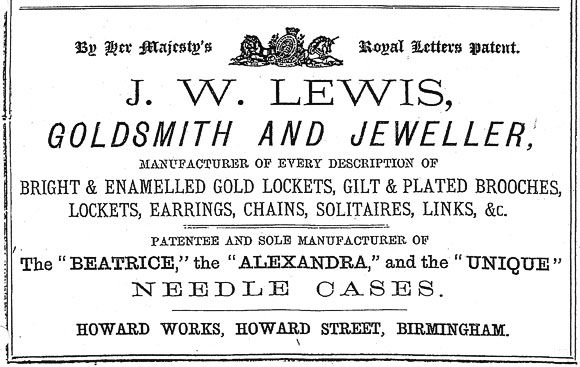
Lewis’s designs don’t usually have a company name imprinted or stamped on them. Most Beatrice needle cases we see today only contain the words “Beatrice” and “Patent” on the end flaps. Occasionally we will find a Beatrice with the interior panels marked H. Milward & Sons or Arthur James, two needle manufacturers from Redditch. More rarely one will be found with a special cover designed for Albert Sharpe, a London dressing case manufacturer. With regard to the Gem, which is identical to the Beatrice except the end flaps contain the words “The Gem” and “Patent Perry & Co London”, we know it was produced until at least 1876 the year in which it was advertised. The Alexandra has its name stamped on the clasp/catch whereas the Unique’s name is stamped on an interior flap. Occasionally one finds a second version of the Unique with a horse and rider pattern on the exterior cover and the name R. J. Roberts. Although all of Lewis’s designs are flat-style needle cases, they contain very elegant stamped designs and almost feel like a piece of fine jewelry. One common feature with Lewis's creations is that every section of brass is filled with some type of decorative pattern. For example, the exterior of the Alexandra is covered with an elaborate floral design surrounded by a pattern resembling a woven basket.

Milward’s Entry
The second Avery style needle case designer to appear on the scene was none other than Henry Milward & Sons, a major needle manufacturer from Redditch. In fact, at one point in the 19th century Milward was considered the largest needle manufacturer in the world. Milward used his connections with the French when he patented his Fan and Bellows needle cases on January 1, 1868 which included a communication from Theodore Givry of Paris. Not only did Givry apply in the UK for the provisional patents for these designs a few months earlier on July 17, 1867 and December 19, 1867, but he also registered a "porte-aiguille systeme eventail" (needle holder fan system) in France a month before on November 9, 1867. This seems to reinforce the idea that Givry actually was the designer of the Fan and Bellows. Again the patents were rather generic, describing the mechanical components of the designs rather than specifying how the fan or bellows panels were to be decorated. Although the patent drawings for the fan and bellows show only four panels, the descriptions indicate they could be made of “paper or pasteboard, or metal or other rigid material”. The Fan needle case is also mentioned in a full page advertisement in an 1871 catalogue, an obvious indication that the company had the financial resources necessary for such a large ad. Whereas the drawing in the ad is rather simplistic, a note on the side claims “The sketch represents a Fan Case embellished with Chromo-Lithography and furnished with Drilled-Eyes Grooveless Needles”. The same item is referenced on another page where it is listed as available with or without “Gilt Metal Sides”. Fan needle cases can be found today with at least six different varieties of brass covers or with no covers at all, solely consisting of four chromolithography covered pasteboard panels; however the latter are not considered Avery style needle cases because they contain no stamped brass. There is also significant variety in the colorful prints found on the interior panels. Most of Milward’s fans either contained his name on the end flap or on the back of the pasteboard panels, although a few have no company name like the bellows.
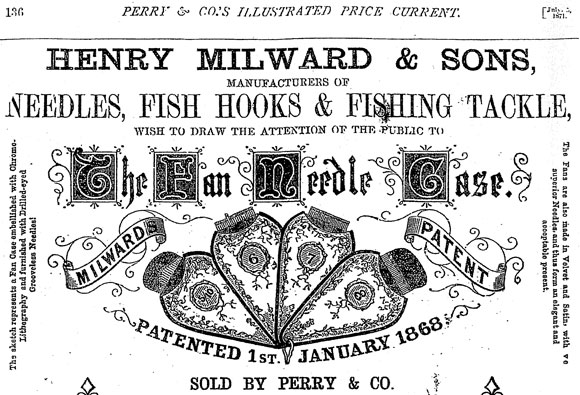
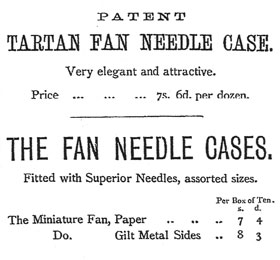
Milward registered three additional metal needle case designs in 1872, two of which appear not to have been produced. The third, named the Victoria, was a flat-style needle case with a buckle-shaped closure. Although a previous author claimed Milward designed several other needle cases, after a thorough search, no patent records have been found to prove this. We know Milward was in business to sell needles not needle cases because he only registered 5 designs and we are not sure if all of these were actually manufactured. Milward preferred to work with other needle case designers so he could license their designs and place his needles in them. Milward’s name is found on needle cases registered by both Lewis and Avery. Selling his needles in their designs helped him sell more needles.
Beginning of Avery’s Revolution
William Avery revolutionized the design of Avery needle cases, hence the reason his name is used to refer to all fancy brass needle cases designed during this time period. However, his early designs were mostly the flat-style. On January 7, 1868, only a few days after Milward registered his Fan, and ten months after Lewis registered his Beatrice/Gem, Avery registered his first needle case, a simple single packet design. While named the Golden Casket on the patent, this design also covers Avery’s other single packet needle cases known as the Golden Needle Case, Needle Casket, Silver Needle Case and the Silver Casket. However, this design varied from those of his predecessors, Lewis and Milward. Avery’s first patent not only covered the interior workings of the design but it also including several very specific drawings, one of a fountain with columns that appeared on one side of the needle case exterior and a flower arrangement that appeared on the other.
Roughly a year later and then another year after that, Avery’s next two patents, registered on November 19, 1868 and October 14, 1869 respectively, were designed in conjunction with the Redditch machinist, Albert Fenton. Both contained detailed drawings and descriptions regarding how the operational components worked, but little to no detail on what the exterior decoration would be. Although these two patents included 31 mostly flat-style design drawings, to the best of our knowledge only six were actually produced. However, of these six, many slightly different versions were actually manufactured because today we find these same needle cases with different exterior decoration: 21 quadruples, 8 demi-quads, 2 lever types, 2 Royals, 2 Athena/Stella’s and a Ladies Companion with three slightly different exterior patterns. Many of these appear to have been designed for specific clients since the ones we find today with unique exterior decoration often contain only one company name. Although we know Avery licensed some of these designs to other firms because the word “Licensee” is also stamped on the item, we don’t know if he was actually involved with the customization or whether the companies created the designs themselves. For example one of these, named the Eclectic Needle Case, was Avery’s basic quadruple model with the Milward name and coat of arms stamped on the exterior. The Eclectic, which contained Milward’s needles, was advertised in catalogues from at least 1871 until 1876. Although it seems unlikely that Avery would have been involved with this customized version since Milward was a major competitor of his in the needle making business, perhaps Avery used these early designs to become better known for his needle cases than his needles. Usually only Avery’s early designs, ones patented before July 1872, have been found with needle manufacturer names other than his own. For example Milward’s name can be found on at least 6 of Avery’s early needle cases.

First Figural Needle Cases
Whereas Lewis and Milward only produced a hand full of designs; Avery would go on to design over 117 different needle cases. During 1870 and 1871 Avery patented 74 mostly flat-style design drawings of which only 12 appear to have been manufactured. Then around the middle of 1871, Avery decided to try his hand at something a bit different, figural needle cases. Because of the restrictive Victorian culture, he knew middle class ladies spent a great deal of their time at home often stitching. Therefore, he decided to create something decorative that would not only appeal to these ladies, but would also be useful, giving them an interesting place to store their needles. This was the perfect time to introduce the fancy brass figural needle case because middle class families created by the industrial revolution had more disposable income and could afford to purchase something purely for decorative purposes. The first ones were the Fish, Universal, Butterfly and Scallop Shell, all designed by the end of 1871. 17 additional figural needle cases were added in 1872 and 14 more in 1873. One, named the Valentine, appeared in an 1873 advertisement and several others were mentioned in an 1876 advertisement (Fir Cone, Hedgehog, Peacock, Rose Pin Case and assorted Shields). From mid-1871 thru 1873 only eleven other firms patented needle case designs. Whereas Avery registered 35 designs during this time period of which 30 were actually manufactured, the other companies patented 18 of which only 12 were produced. The Redditch area needle manufacturers who registered designs during these years were: W. Bartleet & Sons (1), John Croft (1), W. Gould (1 not produced), H. Milward & Sons (3, 2 not produced), James Smith & Son (2) and Joseph Welch (1 not produced). The early Birmingham designers were: Bancroft Brothers (2), Coggins & Baxter (1), John Fenton (2), Henry Jenkins & Sons (1) and Thomas Kendrick (3, 2 not produced).
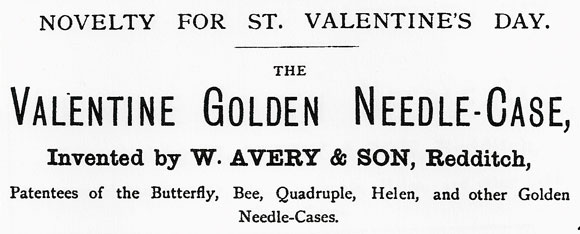
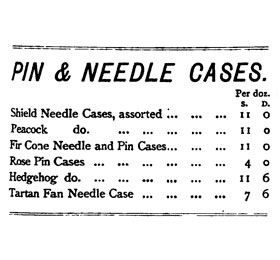
Although in successive years the number of designs registered to Avery decreased, we notice Avery entered a new phase; needle cases with Avery’s name stamped on them which were registered by different companies, all from Birmingham. It seems most likely that Avery never actually manufactured any of the needle cases himself, but rather worked with Birmingham contractors all along. How do we know this? The 1883 floor plan of Avery’s factory in Redditch has been preserved and all of the rooms referenced are specific to needle manufacturing (see History of the Needle) . Also, Avery is only listed in Redditch area city and trade directories as a needle and fish hook manufacturer, never as a needle case manufacturer (see History of W. Avery) , although needle case manufacturers were represented. We know Avery had a business office in Birmingham from at least 1878 until at least 1889 where he made pins according to that city’s directory. In all likelihood, Birmingham die-sinkers took Avery’s ideas and designs and turned them into dies and molds, and then Birmingham stampers used these dies to stamp the designs onto sheet brass to create the individual needle cases. Perhaps after doing this for a few years Avery found it was less expensive to work with companies who handled all of the manufacturing processes in one place rather than having to make the arrangements himself. Another possibility is that all along Avery was using Birmingham die-sinkers and stampers to create his designs but only now did some of these firms want the designs registered in their names. This seems most probable due to the recent discovery of the Butterfly - Filigree needle case patent, registered to Henry Jenkins of Birmingham in 1869, which is only found with Avery’s or one of Avery's licensee names stamped on the back.
Birmingham Boom
In 1874 Avery registered no designs, in 1875 he registered 2 designs, in 1876-7 designs and in 1877-3 designs. Four Birmingham companies registered 26 designs, 19 which were manufactured, during this same time period and most of these were stamped with Avery’s name. Three were die-sinkers, piercers, stampers and toolmakers: Buncher & Haseler registered 12 designs (1874-7, 1875-4 and 1877-1), J. M. Farnol registered 2 (1877-2, 1 not produced) and Frank Kendrick registered 5 (1877-5, 4 not produced). The fourth Birmingham company was the gilt jewelry manufacturer Coggins & Baxter who registered 6 designs (1875-2, 1876-2 and 1877-2) of which only 5 were known to have been produced. All of the designs by Buncher, Kendrick and Coggins, with the exception of two (Coggin’s Hygrometer Weather House and Looking Glass don't contain a company name) are only found with Avery’s or one of Avery's licensee names stamped on them. And how do we know these companies were designing specifically for Avery? Exhibition reports and articles written in the 1870’s, describing the beauty and elegance of Avery’s needle cases, (see 19th Century Descriptions) mention 19 designs of which 5 were registered to Buncher (Wheelbarrow, Victorian Rowboat, Horseshoe, Easel-Floral and Golden Cart), 1 to Coggins (Windmill) and 1 to Farnol (Stile). With regard to Farnol's Stile, the photograph of the design included in the patent contains Avery’s name and, Avery registered two designs in later years (Lighthouse with Boat and Elephant with Howdah) using Farnol’s address as his own on the patent documents. Additionally during those later years Farnol registered another design (Donkey with Panniers) that is only found with Avery’s name or no name.
Beginning of the End
From 1878 to 1880 Avery registered 13 addition figural designs (1878-6, 1879-4 and 1880-3) and continued to work with Farnol. During this period a few others also registered designs: W. Bartleet & Sons (1878-1), Charles James Carr (1879-1), J. Clarke & Son (1879-2), J. M. Farnol (1879-2 and 1880-1), F. Floyd (1880-1), W. Hall & Co (1880-2) and S. Thomas & Sons (1879-1). After 1880 brass needle cases must have gone out of style as Avery registered only a handful of designs in the 1880’s: 1882-1, 1884-1, 1887-1, 1888-1 and 1890-1. Only 2 other brass needle cases were registered during this time period, both by Buncher in 1885 and both were only produced with Avery’s name. Although Avery registered a couple dozen additional designs from 1880-1893 that do not appear to have been produced, these are not included as Avery style needle cases since it is unclear whether they were to be made of brass, paper, pasteboard or some other material.
Summary
In summary, based on the information presented above, the history of Avery needle cases can be divided into the four distinct phases described below. A list showing all needle case registered during each period follows.
Flat Period - represents designs patented from 1867 until the middle of 1871. Most of these are flat-style needle cases designed by Avery, Lewis and Milward. 75 different designs or variations were patented during this period.
Early Figural Period - covers the first figural needle cases designed mainly by Avery from the middle of 1871 through 1873. This was the most prolific period as 53 primarily figural designs can be attributed to this period which only lasted two and a half years. Many of Avery’s most popular figural needle cases come from this period: Bee, Butterfly, Butterfly Box-Oval Tub, Hedgehogs, Scallop Shell, Shakespeare’s Birthplace and the Walnut on Leaf.
Birmingham Beauties Period - represents designs patented from 1874 through 1880 and includes designs mainly by Avery, Buncher, Coggins, Farnol and less than a dozen other Birmingham and Redditch companies and one Liverpool firm. Many of these designs are the most complex and elegant of all Avery style needle cases that were produced. 66 designs were registered during these years including: Arc de Triomphe, Arts and Industry, Beehive Skep, Coal Scuttle, Cock Robin’s Grave, Elephant with Howdah, Golden Cart, Hygrometer Weather House, Invalid Chair, Lion Lying on Plinth and the Temple Bar.
Late Period - covers designs registered after 1880 which were basically designed by or for Avery. Only 7 needle cases were patented during this period including the Eiffel Tower which was produced specifically for the 1889 World’s Fair. In 1890 the last known fancy brass needle case, the Gothic Coffer, was registered.
List of Needle Cases by Period
This list includes the 202 designs for which the patent has been found and the 25 designs for which the patent has not been found. These are listed in the order in which they were registered unless otherwise noted. Additional information and photographs about individual needle cases can be found by going to the Master List.
Flat Period Needle Cases
1867 - Beatrice and Gem - 5 varieties - Lewis & Archbold
1868 - Fan - 6 varieties - Milward & Givry
1868 - Bellows - Milward & Givry
1868 - Golden Casket (2 versions) and Golden Needle Case - 3 varieties - Avery
1868 - Needle Casket - Avery
1868 - Silver Casket (4 versions) and Silver Needle Case - 5 varieties - Avery
1868 - Minerva Lever and Patent Lever - 2 varieties - Avery & Fenton
1868 - Quadruple - 21 varieties - Avery & Fenton
1869 - Unique - 2 varieties - Lewis
1869 - Butterfly Filigree - Henry Jenkins & Sons
1869 - Athena/Stella Golden - 2 varieties - Avery & Fenton
1869 - Demi-Quad - 8 varieties - Avery & Fenton
1869 - Ladies Companion - Avery & Fenton
1869 - Royal - 2 varieties - Avery & Fenton
1870 - Alexandra - Lewis
1870 - Alliance - Avery
1870 - Britannia - Avery
1870 - Duplex - Avery
1870 - Florence - Avery
1870 - Louise - Square - Avery
1870 - Minerva Pincer, Floral Bouquet Pincer and Christmas Pincer - 3 varieties - Avery
1870 - Victoria with Windmill and Horse - Avery
1871 - La Facile - Welch and Laight
1871 - Ladies Needle Album - Welch and Laight
1871 - Constance - Avery
1871 - Diana - Avery
1871 - Revolving - Avery
Total = 75 designs in 4.5 years (56 for Avery = 27 flats, 1 figural, 8 demi-quads and 21 quads)
Early Figural Period Needle Cases
1871 - Fish - Avery
1871 - Universal Pin Case - Avery
1871 - Butterfly - Avery
1871 - Scallop Shell - Avery
1872 - Double Palmette - Milward (patent only)
1872 - Single Palmette - Milward (patent only)
1872 - Pavilion - Bartleet
1872 - Butterfly Box - Oval Tub - Avery
1872 - Oval Tub - Diamond Jubilee - Avery
1872 - Oval Tub - Kaiser Wilhelm I Bust - Avery
1872 - Oval Tub - Ladies Portrait Bust - Avery
1872 - Oval Tub - Scott's Monument - Avery
1872 - Oval Tub - Scott's Portrait Bust - Avery
1872 - Victoria with Belt Buckle - Milward
1872 - Bombe - Avery
1872 - Flower Petal Paperweight - J. Fenton
1872 - Cotton Plant - Smith
1872 - Roses with Buds - Smith
1872 - Cupid's Casket - Avery
1872 - Bee Case - Avery
1872 - Cannon - Avery (patent only)
1872 - Fish with Scallop Shell - Avery (patent only)
1872 - Hedgehog - Avery
1872 - Hedgehog Needle and Pin Case - Avery
1872 - Sovereign Case - Croft
1872 - Swan Needle and Pin Case - Avery (patent only)
1872 - Pyramid Pin Case - Avery
1872 - Bow and Arrows on Heart - T. Kendrick
1872 - Merveille - Gould (patent only)
1872 - Punch - T. Kendrick (patent only)
1872 - Cross - Welch (patent only)
1872 - Butterfly Box - Diamond - Avery
1872 - Nosegay - J. Fenton
1872 - Valentine - Avery
1873 - Shield with Yorkshire Terrier - T. Kendrick (patent only)
1873 - Bird on a Box - Jenkins
1873 - Metallic Pin Box - Avery
1873 - Walnut on Leaf - Avery
1873 - Butterfly Box - Semi Circle - Avery (patent only)
1873 - Peacock - Avery
1873 - Shakespeare's Birthplace Large - Avery
1873 - Shakespeare's Birthplace Small - Avery
1873 - Shield with Lady's Portrait Bust - Avery
1873 - Shield with Stag Head - Avery
1873 - Swan - Avery
1873 - Fir Cones - Avery
1873 - Shield with Bird - Avery
1873 - Shield with Rose - Avery
1873 - Sheaf of Wheat - Avery
1873 - Windmill - Coggins
1873 - Bird's Nest Pin Case - Avery
1873 - Dog on Plinth - Bancroft
1873 - Sewing Beetle on Plinth - Bancroft
Total = 53 designs in 2.5 years (35 for Avery = 1 flat and 34 figural)
Birmingham Beauties Period Needle Cases
1874 - Victorian Rowboat - Buncher
1874 - Penny Stamp - Buncher
1874 - Penny Stamp -Rowland Hill - Buncher
1874 - Butter Churn - Buncher
1874 - Horseshoe - Buncher
1874 - Wheelbarrow with Holly - Buncher
1874 - Wheelbarrow with Roses - Buncher
1875 - Dog in Kennel - Coggins
1875 - Maltese Cross with Folding Arms - Avery
1875 - Picnic Basket - Buncher
1875 - Queen's Footstool - Avery
1875 - Cradle - Buncher
1875 - Easel - Diamond Jubilee - Buncher
1875 - Easel - Floral - Buncher
1875 - Bird Cage - Coggins (patent only)
1876 - Chair - Avery
1876 - Butterfly on Morning Glory - Avery
1876 - Postal Weight - Avery
1876 - Park Chair - Coggins
1876 - Drum - Avery
1876 - Wishing Well - Avery
1876 - Metal Ribbon - A. Fenton (patent only)
1876 - Work and Game Table - Avery
1876 - Archery Society - Avery
1876 - Lap Desk - Floral - Coggins
1877 - Palace Needle Case - Woodfield
1877 - Cleopatra's Needle - Avery
1877 - Hector - Atkins
1877 - Bower - Farnol
1877 - Golden Cart - Buncher
1877 - Looking Glass - Coggins
1877 - Camp Kettle - Avery
1877 - Coal Scuttle - Avery
1877 - Basket - Carr
1877 - Boot and Rink Skate - F. Kendrick (patent only)
1877 - Coal Vase - F. Kendrick (patent only)
1877 - Trolley and Box - F. Kendrick
1877 - Banner Screen - F. Kendrick (patent only)
1877 - Knife Basket - F. Kendrick (patent only)
1877 - Stile - Farnol (patent only)
1877 - Hygrometer/Weather House - Coggins
1877 - Locket - Atkins
1877 - Needle and Cotton Bag - Atkins (patent only)
1878 - Temple Bar - Avery
1878 - Arts and Industry - Bartleet
1878 - Arctic Sledge - Avery
1878 - Invalid Chair - Avery
1878 - Lighthouse with Boat - Avery using Farnol’s address
1878 - Kindling Box - Avery
1878 - Guitar - Avery
1879 - Arc de Triomphe - Avery
1879 - Flat Iron - Clarke
1879 - British Flag Cart - Thomas
1879 - Bathing Machine - Clarke
1879 - Trunk with Grain and Straps - Carr
1879 - Hatbox - Avery
1879 - Leaning Tower of Pisa - Avery
1879 - Beehive Skep - Avery
1879 - Donkey with Panniers - Farnol
1879 - Water Pump with Trough - Farnol
1880 - Elephant with Howdah - Avery using Farnol’s address
1880 - Seated Cherub with Book - Farnol
1880 - Picture in Cruciform Frame - Floyd
1880 - Cock Robin's Grave - Avery
1880 - Chinoiserie - Hall
1880 - Lion Lying on Plinth - Avery
Total = 66 designs in 7 years (Avery = 25 figural)
Late Period Needle Cases
1882 - Punch and Judy Theater - Avery
1884 - Metallic Casket - Avery
1885 - Beef Serving Cart - Buncher
1885 - Crab on a Platter - Buncher
1887 - Rolling Pin - Avery (patent only)
1888 - Eiffel Tower - Avery
1890 - Gothic Coffer - Avery
Total = 7 designs in 10 years (5 for Avery = 1 flat and 4 figural)
Patents Not Found (in alphabetic order by name)
Abel Morrall -signed by Morrall
Albert Needle Case - unsigned
American Eagle - signed by Moffat
Bath Chair - unsigned
Carpet Bag - signed by Avery
Dog Carrying Woven Basket - signed by Avery
Empress -signed by Wyers
Goat with Panniers - signed by Avery
Hermetical - signed by Johnson
Kwikso - signed by Johnson
La Belle - signed by Johnson
Lap Desk - Diamond Jubilee - signed by Avery
Lap Desk - Oval Cartouche - signed by Avery
Lap Desk - Royal Portrait Busts - signed by Avery
Louise - Folding - signed by various
Mantel Clock - unsigned
Painted Scrolls - signed by Bagallays
Organ Grinder - signed by Hall
Pocket Pin Case - signed by Avery
Raised Wheat - signed by Hall
Rose Pin Case - signed by Avery
Sedan Chair - signed by Avery
Star - signed by Avery
Table Swivel Mirror - unsigned
The Prince Needle Preserver - signed by Townsend
Umbrella - unsigned
Total = 26 designs without patents




